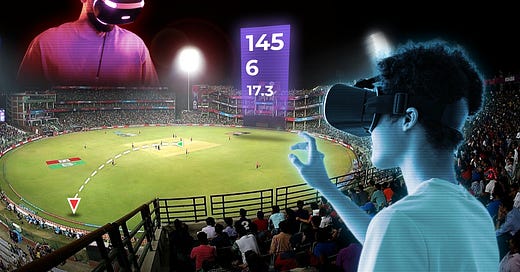Cricket is one of the most innovative sports in the world. Think of all the developments and additions even since the 1980s – floodlights, white balls, coloured-clothing, helmets, stump cams, Hawk-Eye, snick-ometer and ultra-edge, T20, T10, franchise tournaments, DRS, spider cam, flashing bails, free hits and most recently, in the IPL, impact players, one of which you can add at any time in the match. The next thing will be watching the game in 3D through an Occulus headset - if Meta has anything to do with it. While all this has been going on football has largely stood still. Because it can, I guess.
And now we have iHawk. Devised by the same man who invented Hawk-Eye – Paul Hawkins – it is the culmination of several years of research and involves a specially adapted go-pro camera installed in the umpire’s breast pocket. This is on a five second timer triggered by the bowler running in to film the delivery and then transmit the images into the cloud and back to a computer. All the data – like ball maps and trajectories and speeds – that we have been accustomed to seeing from Hawk-Eye is generated and available for interpretation by coaches, analysts and players.
A ball from the recent Hants v Notts game captured by the iHawk camera
The conventional Hawk-Eye uses three fixed camera angles to accurately monitor the path (and future direction) of the ball. The clever thing about iHawk is that it uses only one camera, making its pathway measurements using the diminishing size of the ball as it travels away from the camera. Hawkins says on The Analyst podcast it is 95-98% accurate. It helps if the umpire stays still and upright during the delivery. David Shepherd, who used to invariably hop on one leg when a batsman or a team was on Nelson (111) would have been next to useless.
For the moment iHawk is on trial and only for use by county-club officials as a performance enhancement tool. Although the umpire has a small screen to align the camera, there is no likelihood that he will be able to look back at an lbw decision and evaluate whether the ball pitched outside leg stump or not. Not yet anyway. Though as the original Hawk-Eye, primarily developed to improve the viewer experience, eventually led to DRS, the above scenario cannot be discounted in due course.
iHawk will provide all manner of analytical possibilities for county players
The great thing is it will eventually be available to grassroots teams and schools, enabling a better synchronisation between the amateur and the higher echelons of the professional game. There is currently a disconnect with international cricket – and now the IPL – using technology to deliberate over every minute decision even a wide or waist-high full toss, while club cricket relies on naked (often ageing) eyesight and the inevitable biases of player umpires. Perhaps in future the go-pro can be built into the stumps, negating the need for an umpire at all (just a person in the pavilion monitoring the camera feed.)
Ok we are getting ahead of ourselves here. Chiefly the move is good because it will enable players (and umpires) at all levels to better analyse their performance which should improve standards. And if it forces the moany-old batters trudging off grumbling ‘that was obviously going down leg’ to confront the truth when back with the team analyst then all the better. (Yes I am a cynical old bowler.) And cricket’s innovative reputation continues apace….
I actually filmed this (a three card trick by Anderson) in my kitchen using a green screen







